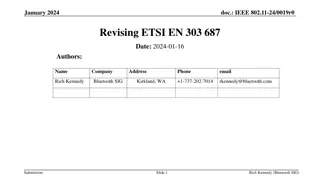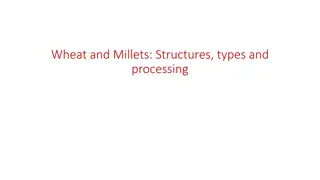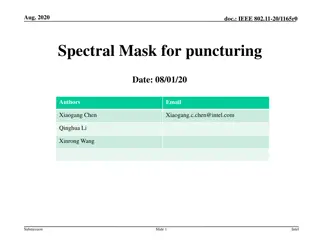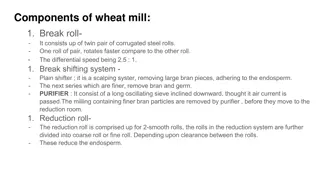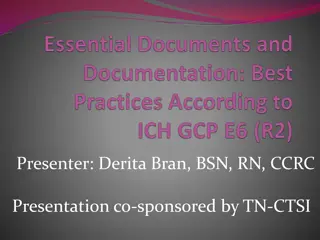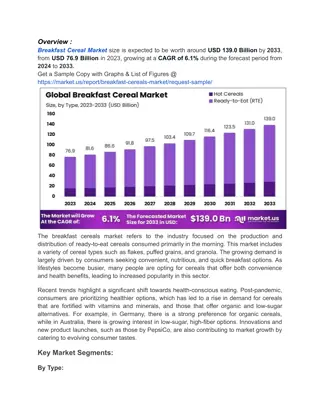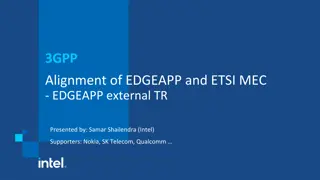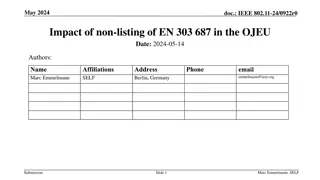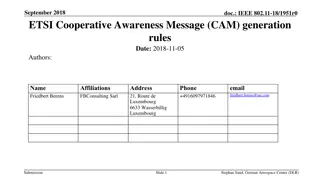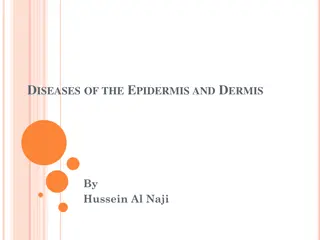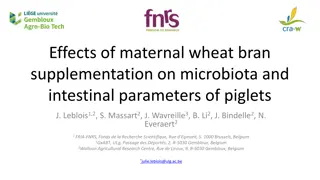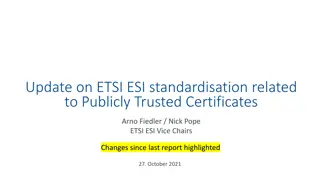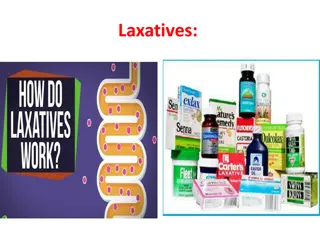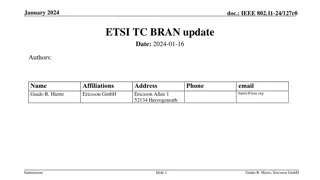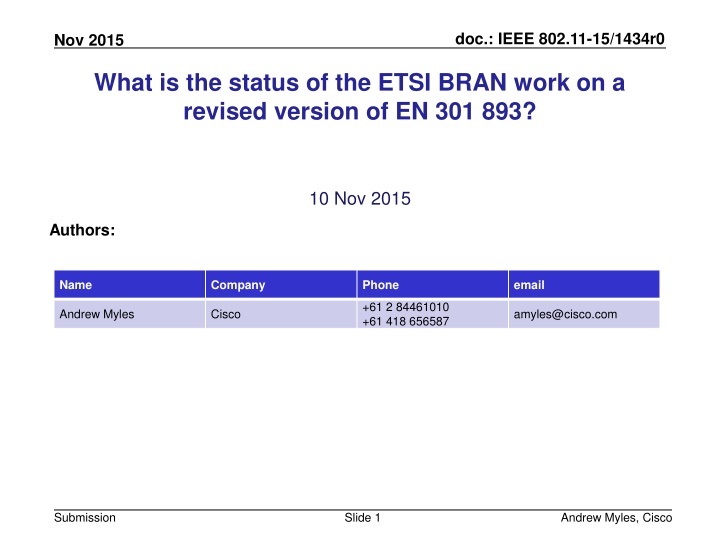
ETSI BRAN Work on EN 301.893 Revision Status Nov 2015
The ETSI BRAN is progressing on the revised version of EN 301.893, focusing on adaptivity and fairness in the 5GHz band for European operations. Companies supporting Wi-Fi coexistence in Europe are encouraged to participate. A revision is needed by early 2016 as per the new European Directive 2014/53/EC to ensure compliance with spectrum use and interference regulations by June 2017.
Download Presentation

Please find below an Image/Link to download the presentation.
The content on the website is provided AS IS for your information and personal use only. It may not be sold, licensed, or shared on other websites without obtaining consent from the author. If you encounter any issues during the download, it is possible that the publisher has removed the file from their server.
You are allowed to download the files provided on this website for personal or commercial use, subject to the condition that they are used lawfully. All files are the property of their respective owners.
The content on the website is provided AS IS for your information and personal use only. It may not be sold, licensed, or shared on other websites without obtaining consent from the author.
E N D
Presentation Transcript
doc.: IEEE 802.11-15/1434r0 Nov 2015 What is the status of the ETSI BRAN work on a revised version of EN 301 893? 10 Nov 2015 Authors: Name Company Phone email +61 2 84461010 +61 418 656587 Andrew Myles Cisco amyles@cisco.com Submission Slide 1 Andrew Myles, Cisco
doc.: IEEE 802.11-15/1434r0 Nov 2015 EN 301 893 revision is progressing in ETSI BRAN but more participation by Wi-Fi folk is encouraged New EN 301 893 is required Most work is focused on fairness in adaptivity Progress is being made but there are open issues 802.11 operation in Europe is based on EN 301 893 as authorised by European Directive 1999/5/EC The work in ETSI BRAN revising EN 301 893 has been focused on a new adaptivity clause ETSI BRAN has made significant progress on a new adaptivity clause but there are still major open issues RSC and TCAM have determined that fairness is a key requirement for adaptivity in the 5GHz band A revision of EN 301 893 is required by early 2016 to support a new European Directive 2014/53/EC Scheduling issues make the development of new adaptivity clauses in EN 301 893 challenging! Companies that want to support Wi-Fi coexistence in Europe are encouraged to participate in ETSI BRAN or at least assist the effort Submission Slide 2 Andrew Myles, Cisco
doc.: IEEE 802.11-15/1434r0 Nov 2015 802.11 operation in Europe is based on EN 301 893 as authorised by European Directive 1999/5/EC IEEE 802.11 equipment is currently subject to requirements authorised by the European Directive 1999/5/EC EN 301 893 documents explicit requirements for operation in the 5GHz band in Europe, as authorised by 1999/5/EC, including: Frequencies Bandwidths Power Spurious emissions DFS Adaptivity EN 301 893 also includes some simple tests against some of these requirements Submission Slide 3 Andrew Myles, Cisco
doc.: IEEE 802.11-15/1434r0 Nov 2015 A revision of EN 301 893 is required by early 2016 to support a new European Directive 2014/53/EC A new EC Directive (2014/53/EC) repeals the previous EC Directive (1999/5/EC) on radio equipment The main objective of the new Directive is to provide: a high level of protection of health and safety, adequate level of electromagnetic compatibility and an effective and efficient use of radio spectrum so as to avoid harmful interference while guaranteeing the proper functioning of the internal market Essential requirements include requirements for effective & efficient use: Radio equipment shall be so constructed that it both effectively uses and supports the efficient use of radio spectrum in order to avoid harmful interference The new Directive comes into effect in June 2017 but EN 301 893 will need to be revised by early 2016 to allow approval and transition processes to be executed in time Submission Slide 4 Andrew Myles, Cisco
doc.: IEEE 802.11-15/1434r0 Nov 2015 The work in ETSI BRAN revising EN 301 893 has been focused on a new adaptivity clause One key element of EN 301 893 is the adaptivity requirement Adaptivity is formally defined as an automatic channel access mechanism by which a device avoids transmissions in a channel in the presence of transmissions from other RLAN devices in that channel. There is an implicit goal of fair sharing of the channel, which is compatible with the goal of 2014/53/EC for effective channel use It is accepted that the current adaptivity clause in EN 301 893 needs a significant rewrite There is a desire to make EN 301 893 more technology neutral , which requires the removal of the direct reference to IEEE 802.11 in the current version The current version of EN 301 893 includes two load based and one frame based adaptivity mechanism that are known to not work ETSI BRAN has been focusing on developing a new adaptivity clause in EN 301 893 since December 2014 Submission Slide 5 Andrew Myles, Cisco
doc.: IEEE 802.11-15/1434r0 Nov 2015 RSC and TCAM have determined that fairness is a key requirement for adaptivity in the 5GHz band The requirement for fairness is implicit rather than explicit in the European Directive 2014/53/EC Fortunately, a meeting of two European Commission committees on 8 Oct 2015 provides clarity Radio Spectrum Committee (RSC) Telecommunications Conformity Assessment & Market Surveillance Committee (TCAM) In a discussion on Compliance of 5 GHz RLANs and LTE unlicensed use in the 5 GHz band (compatibility with other radio applications, coexistence between Wi-Fi and LTE unlicensed) they determined that: coexistence means the fair use of the spectrum, which should ensure equal access for all technologies and applications Submission Slide 6 Andrew Myles, Cisco
doc.: IEEE 802.11-15/1434r0 Nov 2015 ETSI BRAN has made significant progress on a new adaptivity clause but there are still major open issues At the last ETSI BRAN F2F meeting in Oct 2015 it was agreed to base future discussions on EN(15)150r2 (available via liaison agreement) It includes some important agreements, with the most fundamental being it incorporation of LBT with exponential back using a scheme very similar to EDCA It also documents a variety of open issues Most of the issues are minor or editorial and will be resolved over time after ongoing discussions Three open issues can be described as major The major open issues are: What is the definition of the energy detect (ED) threshold? What is an appropriate value of max TxOP? What are the multi-channel requirements? Submission Slide 7 Andrew Myles, Cisco
doc.: IEEE 802.11-15/1434r0 Nov 2015 What is the definition of the energy detect (ED) threshold? There are two options on the table! Evidence based proposal enables fair coexistence Alternate proposal requires us to trust 3GPP to share fairly Proposal ED of -62dBm and PD of -82dBm (like Wi-Fi); OR ED of ~-77dBm Proposal ED of -62dBm Comments Based on the idea that 3GPP can be trusted to define LAA in such a way that it maintains fairness and that all implementers in this band will follow 3GPP rules! Comments The first option is based on status quo for billions Wi-Fi devices The second option is based on 3GPP simulations that show LAA needs ED of ~-77dBm to coexist fairly with Wi-Fi Note: It is asserted many Wi-Fi devices do not satisfy these rules Submission Slide 8 Andrew Myles, Cisco
doc.: IEEE 802.11-15/1434r0 Nov 2015 What is an appropriate value of max TxOP? There are at least two proposals on the table Wi-Fi based max TxOP enables proven fairness LTE based max TxOP promotes efficiency over fairness Proposal 6ms Proposals 10ms; OR 6ms DL + 6ms UL; OR 8ms (compromise?) Comments Value is compatible with max frame length in 802.11 Value based on extensive 3GPP simulations that show fairness between LAA & Wi-Fi, particularly for real time QoS traffic Note: it is asserted many Wi-Fi devices do not satisfy this rule Comments Use of larger value promotes efficiency over fairness Longer value allows for UL and DL in LAA, as well as LTE protocol derived delay between DL ending and UL starting Submission Slide 9 Andrew Myles, Cisco
doc.: IEEE 802.11-15/1434r0 Nov 2015 What are the multi-channel requirements? There are at least two proposals on the table Wi-Fi based multi-channel promotes LAA/Wi-Fi fairness Looser multi-channel prioritises efficiency over fairness Proposal Use a primary/secondary multi- channel similar to 802.11 Proposal Allow all of the multiple channels to be a primary channel and once access gained, allow the remaining channels to be a secondary channel Comments Using same mechanism as Wi-Fi guarantees fair sharing Comments This mechanism allows LAA to make more efficient use of multiple channels but at cost of unfair access to the channel compared with Wi-Fi Submission Slide 10 Andrew Myles, Cisco
doc.: IEEE 802.11-15/1434r0 Nov 2015 Scheduling issues make the development of new adaptivity clauses in EN 301 893 challenging! EN 301 893 needs to be finished very soon, but probably by March 2016 at the latest to allow time for approval and transition At the same time: 3GPP is developing LAA with a nominal completion date of March 2016, but probably later and IEEE 802.11 WG is developing 802.11ax, with a nominal completion date of ~1919 and billions of IEEE 802.11a/n/ac need to remain compatible with the EN 301 893 revision The challenge is that a revision of EN 301 893 needs to enforce fair sharing of the 5GHz band between technologies that already exist and multiple technologies in various stages of development without unduly limiting innovation Submission Slide 11 Andrew Myles, Cisco
doc.: IEEE 802.11-15/1434r0 Nov 2015 There are two proposals in ETSI BRAN to address the scheduling challenge Two step is based on what we know at various times Open is based on trusting all to do the right thing Proposal Define EN 301 893 based on what we know about LAA/802.11a/n/ac coexistence today Once complete start a new project to revise it again once we know more about LAA and LAA/802.11ax coexistence Proposal Define EN 301 893 once with very broad constraints to ensure innovation is not constrained Comments This approach relies on 3GPP (and promoters of other technologies) to design their protocols to share fairly It also puts the ability of Wi-Fi to fulfil the promise of anyone, anytime, anyplace can put together a network that meets their needs Comments This approach is a nice balance between allowing innovation, while ensuring coexistence and not risking the immense value of Wi-Fi today Submission Slide 12 Andrew Myles, Cisco
doc.: IEEE 802.11-15/1434r0 Nov 2015 Companies that want to support Wi-Fi coexistence in Europe are encouraged to participate The goal of todays presentation is twofold Inform IEEE 802.11 WG about the work being done in Europe to protect the huge socioeconomic value derived from Wi-Fi (noting this work will have an indirect impact on sharing in the US and around the world) Encourage IEEE 802.11 WG members to participate in the ETSI BRAN process - the companies that have supported Wi-Fi in this forum are few in number but have had a massive impact thank you! If your company is an ETSI member then you can participate in a Teleconference on 3 December F2F meeting in Germany on 14-18 December If you are not an ETSI member you can still help by contributing to the work of those companies supporting Wi-Fi in ETSI BRAN Contact Andrew Myles (amyles@cisco.com) for details Submission Slide 13 Andrew Myles, Cisco


